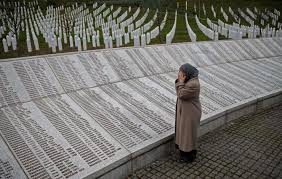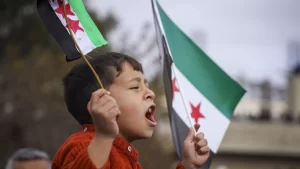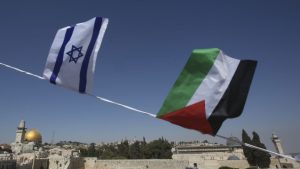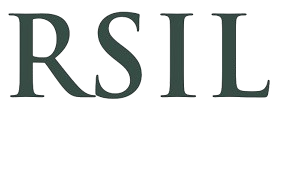
Thirty years after the Srebrenica genocide. The victims’ legal odyssey
Thirty years after the Srebrenica genocide. The victims’ legal odyssey Written for the componente: Armed conflicts Thirty years after
8:12 am, January 12, 2024. Daniel R. Quiroga-Villamarín ©.
From the early hours of the morning, and despite the cold winter temperature, the Carnegieplein was filling up with people. The first to arrive were the journalists, who from early in the morning struggled to find a suitable space for their camera tripods. Then followed us – the students of that year’s winter courses of The Hague Academy of International Law – who had to enter the premises at a certain time for security reasons. But little by little, the small triangular square was filling up with people, flags, and shouts. On the last two days of that week, January 11 and 12, the oral hearings of the lawsuit filed by South Africa against Israel before the International Court of Justice for alleged violations in the Gaza Strip were convened. During those two days, dozens of demonstrators (both those in favor of one of the two “sides”, Israel or Palestine, and many others claiming only to be on the side of “humanity”), filled the square to remind the judges of the Court that the eyes of the whole world were watching them.
Exactly three weeks later, Carnegieplein was back in the media spotlight. On January 26, the Court issued its first order for provisional measures – which were updated on March 28. After hearing both parties in dispute, the Court concluded that there was a “real and imminent risk” of irremediable harm to the rights in question (para. 74), and therefore ordered the State of Israel to take a series of binding measures to prevent such harm. Although the Court did not, per se, order a ceasefire or grant the measures strictly requested by South Africa, it did ask Israel to take action to prevent the occurrence of acts that may be prohibited by the Convention, as well as to allow the entry of humanitarian supplies and preserve relevant evidence. Perhaps the most important measure is that the Court decided, as in the previous case of Gambia v. Myanmar, that the respondent state had the responsibility to issue a compliance report on the measures requested (para. 82).
The orders for measures decreed by the World Court – as the International Court of Justice is colloquially called – as well as the case in general, have been – deservedly – at the center of public discussion. Other blog posts have explored the legal consequences of the orders (see, for example, here, here, here, or here). Some interventions, usually close to the State of Israel, have accused South Africa of using the law for political purposes (for which the nebulous term “lawfare” is often used, see also here). As I write this post, there has been a heated debate on Twitter about whether the Court really considered that there was a “real and imminent risk” of genocide, which was triggered by the intervention of a famous Israeli international law professor at the University of Vienna at the end of April (see also here or here). From the South African or Palestinian perspective, however, the intervention at The Hague has been celebrated as a heroic use of international law at a time when the world needed it most. South Africa has also sought a ruling from another court in The Hague, the International Criminal Court, on the situation in West Asia. For its part, Nicaragua has filed a lawsuit in the same court against the Federal Republic of Germany, claiming that its support for the State of Israel goes against its duty to respect international humanitarian law. Ultimately, the responses to the case have, in a way, replicated the adversarial structure of the case: interventions in favor of the respondent state vis-à-vis those in favor of South Africa.
In this blog post, however, I want to argue that the measures order (and the case in general), has implications for actors beyond the two disputing parties. This is obvious in the case of the Palestinian nation, on behalf of which South Africa is making its intervention. In my view, another indispensable actor – and somewhat underexplored by reactions to the orders or the case – is the United Nations (UN), as such. Beyond the two litigants, the two orders for provisional measures issued by the World Court cannot be understood without reference to the activities of the UN as an institutional whole. Ultimately, what we see is that the International Court of Justice (through the orders) is exercising its mandate to serve as ‘the Chief Judicial Body’ of this international organization and thus seeks to uphold not only the rights of the Palestinian nation but also of the institution itself.
This mandate is not obvious, from a traditional perspective, with respect to the role of the Court – and of law – in the so-called “international community”. When mechanisms for resolving disputes between states (such as international tribunals or arbitral proceedings) first emerged, they tended to be governed solely by a bilateral logic. The Permanent Court of International Justice created in The Hague in 1920, which has been seen as the institutional forerunner of today’s World Court, had an ambiguous relationship with the League of Nations – which, in turn, has been seen as the forerunner of today’s UN. The point of such mechanisms was not to build a multilateral order, but to resolve purely bilateral disputes. This is especially clear in arbitration proceedings – for example, those before the mechanisms of the Permanent Court of Arbitration, which shares the Peace Palace with the International Court of Justice. With the creation of a new international organization after World War II, there was a conscious decision to integrate the new World Court with the UN, making it an organ of the new institution. This mandate to serve as the ‘Chief Judicial Body‘ of the institution has informed the Court’s approach to judicial interpretation in certain cases – most famously, in its 1962 advisory opinion on Certain Expenses of the United Nations. In my view, the same is true in the case under study.
In the two orders for provisional measures, the UN is a silent protagonist. In reaching its decision – and especially in assessing the factual situation in the Gaza Strip – the World Court makes extensive use of documents produced by the various UN agencies involved in the Strip. For example, the Court begins its analysis in the first order by noting that the conflict in Gaza has been extensively debated by the UN General Assembly and the UN Security Council (para. 14), and then concludes that its judicial mandate is strictly limited to the Convention under study. Subsequently, to assess the extent of the destruction caused by the Israeli military operations in the Gaza Strip, the Court turns to figures compiled by the UN Office for the Coordination of Humanitarian Affairs (para. 46), the World Health Organization (para. 48), the United Nations Relief and Works Agency for Palestine Refugees in the Near East (para. 49 UNRWA, see its history here), or a joint report prepared by 37 special rapporteurs (para. 53). Finally, to assess the existence of an imminent risk, the Court also cites a letter from the Secretary-General of the Organization (para. 67, among other official sources). The Court’s decision, in other words, is supported by the work of an extensive network of institutions representing the “international community.”
Given the sensitive nature of the allegations made by South Africa, it is easy to understand why the Court sought to base its arguments on “international” sources – which can be seen as “neutral” or “impartial,” especially in the face of some of the more politicized sources of information that are often invoked in this debate. However, the UN has an importance in this case that goes beyond being a mere collector of information. Although in the first order the Court had already ordered the State of Israel to allow the “provision of urgently needed basic services and humanitarian aid” in the Strip (measure 4), in the second order the Court explicitly mentions the organization (measure 2(a)). In this regard, it orders Israel to “take all measures to ensure, without delay and in full cooperation with the UN, the provision of basic services and humanitarian aid.” In reaching such a conclusion, in the second order, the Court also makes extensive use of UN sources (paras. 31-39).
In fact, there is only one official UN figure that is conspicuous by its absence: the high death rate of its agents in the conflict in the Gaza Strip. Nor is there any mention of UN responses to allegations made by Israeli agents of alleged collusion between UNRWA and Palestinian armed actors in the face of atrocities committed against civilians by Hamas on October 7, 2023. The UN, in other words, is no stranger to the tragedy of the Gaza conflict – and this explains, in my view, its relevance in the World Court’s approach to the question of provisional measures. Ultimately, the argumentation and substance of the requested measures seek not only to protect the rights of the Palestinian nation, but also of the UN as an institution called upon to speak on behalf of the international community.
This is not to suggest that the UN has “taken sides” in the conflict. The UN’s relationship to the conflict in West Asia is extensive and has mutated dramatically over the decades since the partition of the Mandate of Palestine was debated in its midst in late 1947 (see generally here). Although in recent years there has been a growing “anti-UN” sentiment in certain sectors of Israeli society, it is important to remember that in some ways the creation of that state owes much to UN processes (see here). Moreover, while the Court is the principal judicial organ, it is clearly not the only one. As the order recognizes, there are a plurality of agencies (with different mandates) that represent the UN on the ground. My point is that the orders show that the World Court has recognized that in this instance its mission goes beyond resolving a dispute between two states. On the contrary, the Court has recognized that today, in the Gaza Strip, not only the future of the Palestinian nation but of the international order – and of the so-called “international community” as such – is at stake.
No one would expect that, in making the decision on the partition of the Mandate of Palestine 77 years ago, the UN would end up sowing the seeds of its own demise. And that need not be the fate of the organization – as hundreds of its agents in the field continue to risk their lives for the organization to fulfill its mandate to preserve humanity. That is why the report ordered to Israel – which is confidential in principle – is one of the most potentially significant elements of the orders issued under the Court’s provisional measures. By requiring the Israeli authorities to maintain a constant reporting mechanism to the UN (and to the Court in particular), such information may prove crucial for other organs of the institution to proceed with their operations on the ground and before multilateral bodies. There is always the risk that such a request may end up becoming mere “paperwork” – and there is a long history of accusations that international law is nothing more than a castle made of pieces of paper. But that is the only hope left for those of us who come to Carnegie Hall to see the “international community” in action – the illusion that a set of papers (orders, treaties, judgments, and reports) can make this planet a little less violent.
Daniel R. Quiroga-Villamarín
Candidato doctoral, Graduate Institute of International and Development Studies
(Ginebra, Suiza)
daniel.quiroga@graduateinstitute.ch
NB: This entry was finalized on May 6, 2024, prior to the third warrant of measures issued by the International Court of Justice on May 24 and the ICC Prosecutor issuing the arrest warrants on May 20.

Thirty years after the Srebrenica genocide. The victims’ legal odyssey Written for the componente: Armed conflicts Thirty years after

The necessity of public and governmental support for transnational justice: the case of the Kosovo Specialist Chambers Written for the

Syria’s Transitional Government and International Law Written for the component: Peace Building and transitions Syria’s Transitional Government and International

An Unlawful Occupation of a Devastated Territory Written for the component:Armed Conflicts: Gaza “The dialogue of the occupying power

From Chaos to Clarity: How Conflict Classification Enhances Peacebuilding Written for the component: Peace Building and Transitions Introduction In today’s

Last Three Years Without serious consequence: Overview of the nature and Challenges of Russia’s War Against Ukraine under The International


To receive more information about our newsletter, please leave us your email address.